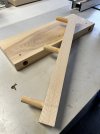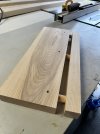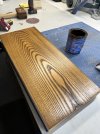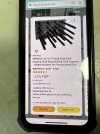All
So we are planning to install 4 'floating' shelves in the corner of a room (no visible mounting brackets).
Each shelf will end in a corner of the room, and therefore will be contact with 2 walls: one end and the back will be on the wall.
This 2-walled installation takes care of the issue of supporting the projecting front section of each shelf. I have only done floating shelves once and those were the same idea - 2 walled installation that went well; no brackets or special hardware required.
These will be 8/4 poplar shelves that are 6-12" wide x by 20-48" long (or could also be described as 6-12" deep x 20-48" wide). I plan to route large grooves into the back and end of each shelf to house the 'cleats' that will be wall mounted (screws into studs). Once mounted on the cleats I will use a small finish nail or screw to retain the piece in place.
Given almost 2" thickness, what dimension would you choose for the cleat? I was thinking of a 1 or 1.25" square, with the cleat running to the within 1" of the end or edge of the board. At 1.25" this would leave 3/8" above and below the cleat. Or I could offset the groove to have more thickness above the cleat and only 1/4" below it. The material below the cleat only captures the cleat but does not really aid in supporting the shelf.
Cross section of the shelf.:

Given what I have described - what would you do?
If we can manage it, we will 'prevent' our adventurous/inquisitive/acrobatic cat from making this his playground, but one never knows with a feline. Ask me in year whether I have created the best challenge ever and a new playground for our cat, or whether these are decorative & functional shelves.
So we are planning to install 4 'floating' shelves in the corner of a room (no visible mounting brackets).
Each shelf will end in a corner of the room, and therefore will be contact with 2 walls: one end and the back will be on the wall.
This 2-walled installation takes care of the issue of supporting the projecting front section of each shelf. I have only done floating shelves once and those were the same idea - 2 walled installation that went well; no brackets or special hardware required.
These will be 8/4 poplar shelves that are 6-12" wide x by 20-48" long (or could also be described as 6-12" deep x 20-48" wide). I plan to route large grooves into the back and end of each shelf to house the 'cleats' that will be wall mounted (screws into studs). Once mounted on the cleats I will use a small finish nail or screw to retain the piece in place.
Given almost 2" thickness, what dimension would you choose for the cleat? I was thinking of a 1 or 1.25" square, with the cleat running to the within 1" of the end or edge of the board. At 1.25" this would leave 3/8" above and below the cleat. Or I could offset the groove to have more thickness above the cleat and only 1/4" below it. The material below the cleat only captures the cleat but does not really aid in supporting the shelf.
Cross section of the shelf.:
Given what I have described - what would you do?
If we can manage it, we will 'prevent' our adventurous/inquisitive/acrobatic cat from making this his playground, but one never knows with a feline. Ask me in year whether I have created the best challenge ever and a new playground for our cat, or whether these are decorative & functional shelves.




